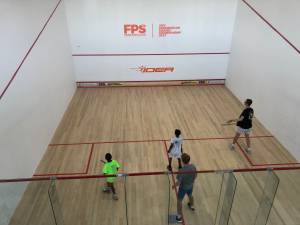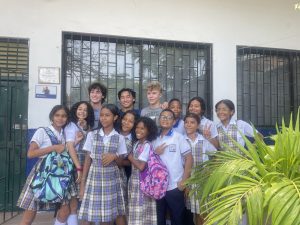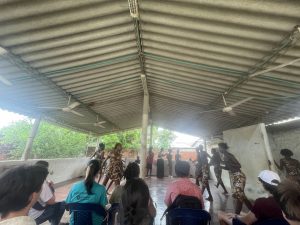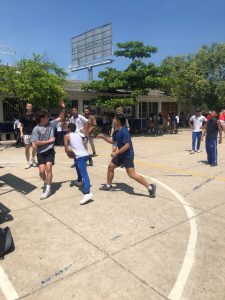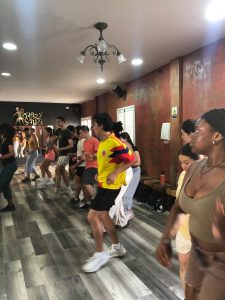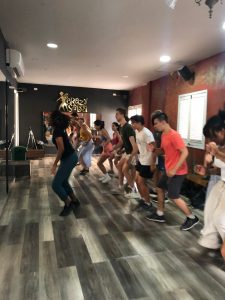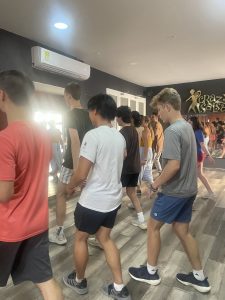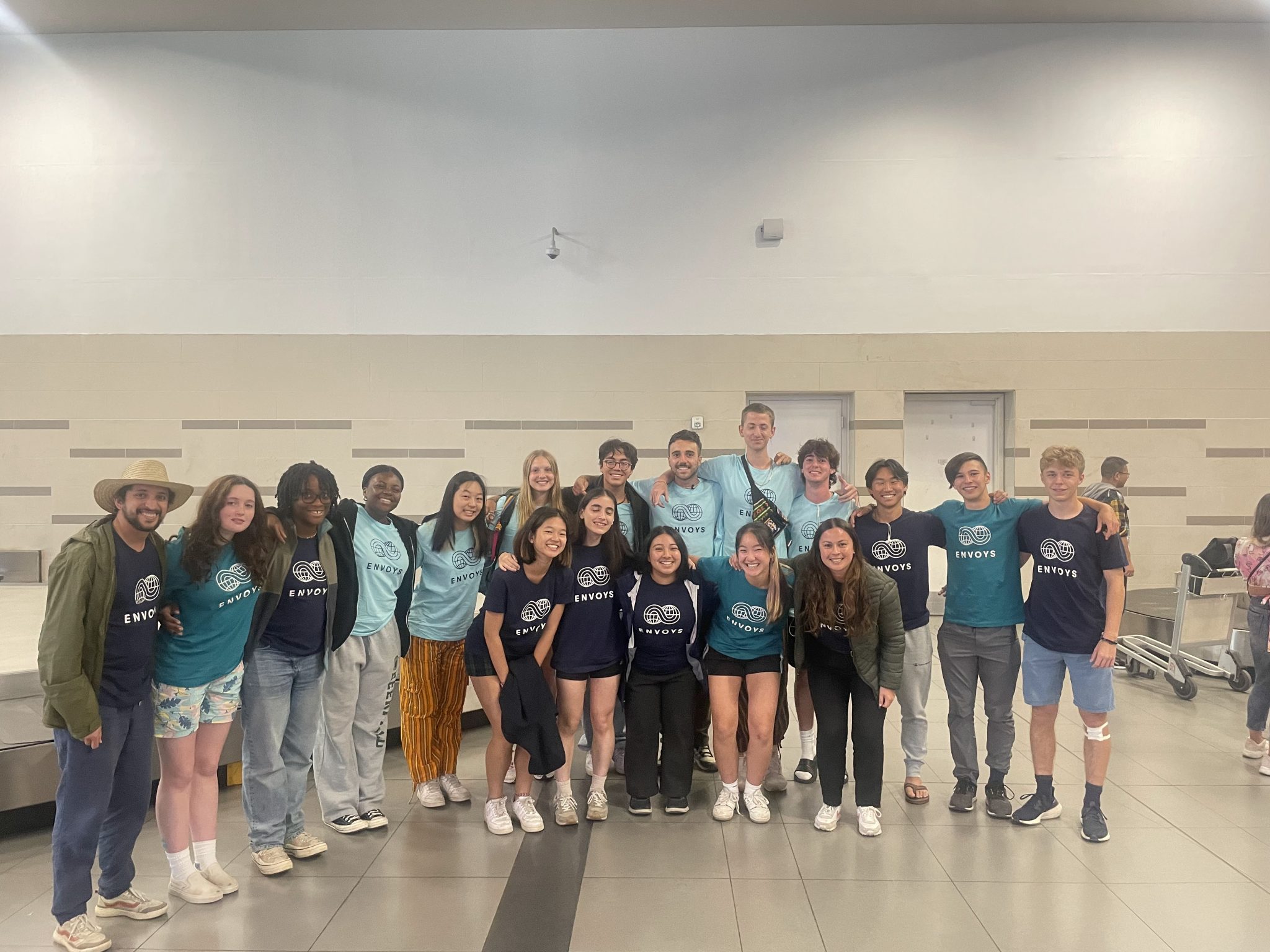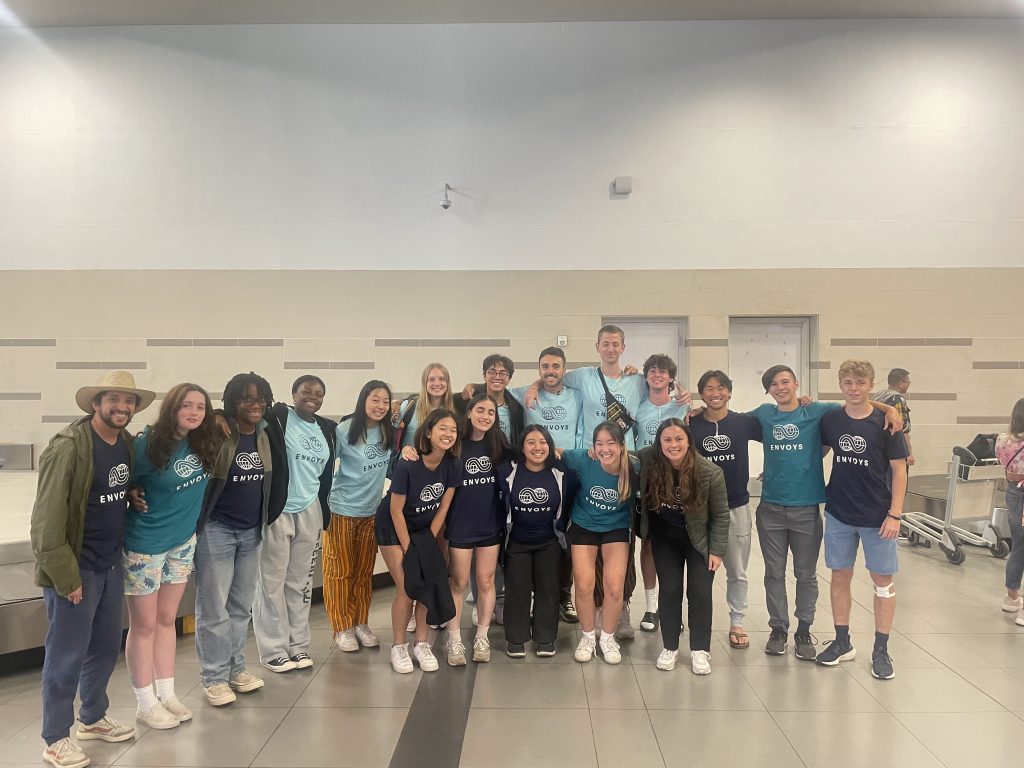David ’25 and Anthony ’25, describe how the groups experiences have allowed them to fully immerse in the Colombian culture.
Today, our verb of the day was indagar, a verb without a perfect translation into English. Approximately, indagar means “to research,” but the verb actually expresses a deep exploration into a specific topic through testing hypotheses, gathering evidence, and most importantly establishing a personal connection with your material. Indagar needs a true commitment to learning and understanding. Today, we had a series of cultural experiences under the hot sun of Cartagena that allowed us to fully embrace the opportunity to indagar in our immersion in Colombia. During the jampacked day, we explored Colombian sports with a trip to a squash center focusing on youth development, we made a final visit to a nearby school, we interviewed Cartagena locals and tourists about the culture and history of Cartagena, and finally we learned about Colombian music and dance with a lesson in cumbia and salsa dance.
We started off the day by heading to the squash courts. It was our lucky day, as the Pan-American Squash Championships were being played in Cartagena. This event featured men’s and women’s teams from the USA, Canada, Mexico, Barbados, Colombia, Ecuador, Paraguay, Peru, Bahamas, and more. It was a great experience to see thrilling matches from some of the top players in the world. We were especially lucky to watch world #1 Diego Elias compete for Peru, as well as well as world #13 Miguel Rodriguez of Colombia. As we were watching, we rotated on and off the court, getting the chance to play doubles squash in teams of two – one student from Deerfield and one from Squash Urbano Colombia. They had players of all ages ready to play with us. Our abilities ranged from beginners to Deerfield squash players, but we all learned from their great coaches and players.
During our visit to the squash courts, I (David) had the opportunity to hold a conversation with one of the Colombian squash players, a 10th grader and lifelong Cartagena resident named Angelo. Angelo attends public school in the city, but has received greater educational opportunities through Squash Urbano Colombia. Through our conversation, I was able to indagar as I connected with his life by comparing our different school days, the classes we take, the sports we play, and our dreams beyond high school, such as how Angelo wants to study finance at university. The conversation skills we’ve learned on this trip allowed me to learn about and empathize with his life in the neighborhood of Getsemaní in the context of his five year long journey through squash. For the first time on this trip, while conversing with Angelo, I no longer felt as though I was simply observing Colombia; I felt as though I was finally truly interacting directly and at length with the people and the stories of this richly diverse country by trading life stories with a Colombian the same age as myself. Through our conversation, my personal connection with Colombia played a key part in making the most of the verb indagar.
After squash, we visited the school that the students enrolled in Squash Urbano Colombia study at. It was recess, so students were outside with friends. We got to have conversations with many different students, as well as learn some games from them. Also, we played a game of pick-up basketball. We then received a tour of the school, also learning some information about it. Because there is a lack of classroom space and teachers, there are four sessions of school per day. Some students study as early as 6 AM, while others are at school until 9 PM every night. When speaking with some of the students, we found that some of the teachers were unreliable, sometimes not showing up for class.
Next, after a quick break at the hotel, we headed out to lunch. It was there when we learned of our next task: interviews. In groups of three, we went out into the streets of Cartagena, looking to indagar culture and lifestyle of locals. We prepared questions to start, but were encouraged to speak from the heart, focusing on having meaningful conversation, not sticking to the script. As my (Anthony’s) group was looking for someone to interview, we walked into a bookstore. We approached the manager, told her what we were doing, and she agreed to let us interview her. She started off by telling us about herself. She is in her mid 30s, and has been living in Cartagena her whole life. She has no desire to move, as she loves the beach and the warm weather. Later, she told us how she feels about her job. She loves it because she enjoys reading, and has been working in the store for nine years. We asked if it was her dream job, and she opened up to us about her life. Since she was a child, her dream was to be a teacher for young kids. However, when faced with struggles in her life, she couldn’t continue to study, needing to quit and earn money. She told us not to make the same mistake as her, that when times get hard, you must stay focused on your dreams.
At the end of our long day, we moved into a fun and interactive part of Colombian culture: dance. Our entire group had been waiting to dance, and we enthusiastically entered a small, air-conditioned dance studio among the many small rooms throughout the walls of Cartagena. After a quick warm up stretch, our instructor leapt into a demonstration of cumbia dance, a strong monument to Colombian culture. As I (David) clumsily fell into the eight step rhythm alongside the rest of the group, I appreciated both the fun aspect of cumbia as well as its cultural, story-telling significance. On one hand, I enjoyed the progression as we moved into strong steps forward and backwards and lively expressions using our whole bodies, including using our forearms as machetes, twisting from side to side, and making hops and strides, all in unison. On the other hand, we learned that cumbia was inspired by African traditions brought to Colombia alongside slaves, and how important cumbia is to Colombia as an expression of national history and cultural progression. The messages behind cumbia are as powerful as the steps and the gestures. The second dance we learned was salsa, a fun and casual partner dance. Salsa has a quick 8/8 tempo in which you move left-right-left pause right-left-right, moving forwards and backwards in one area. As I progressed past the stumbling first attempts, I picked up linear salsa, which has you stepping back and forth and pulling and pushing your open salsa, which gives you an open position to step right and left in, and Cuban salsa, which has you step back with each leg before coming back to the center. Once the group fell into rhythm, we danced in pairs, feeling the rhythms of Colombian music. In this moment, swaying to a sweet Spanish voice, we again dove into Colombian culture, emulating the idea of indagar by participating actively and enjoying ourselves in Colombian dance and music.
In this moment, as the sun set on the hot city of Cartagena, we came to the end of a day filled with authentic connection to the culture we had been surrounded by for the week. Our trip was, definitively, no longer a trip to idly observe a country, but finally one to immerse ourselves in all that is Colombia.
